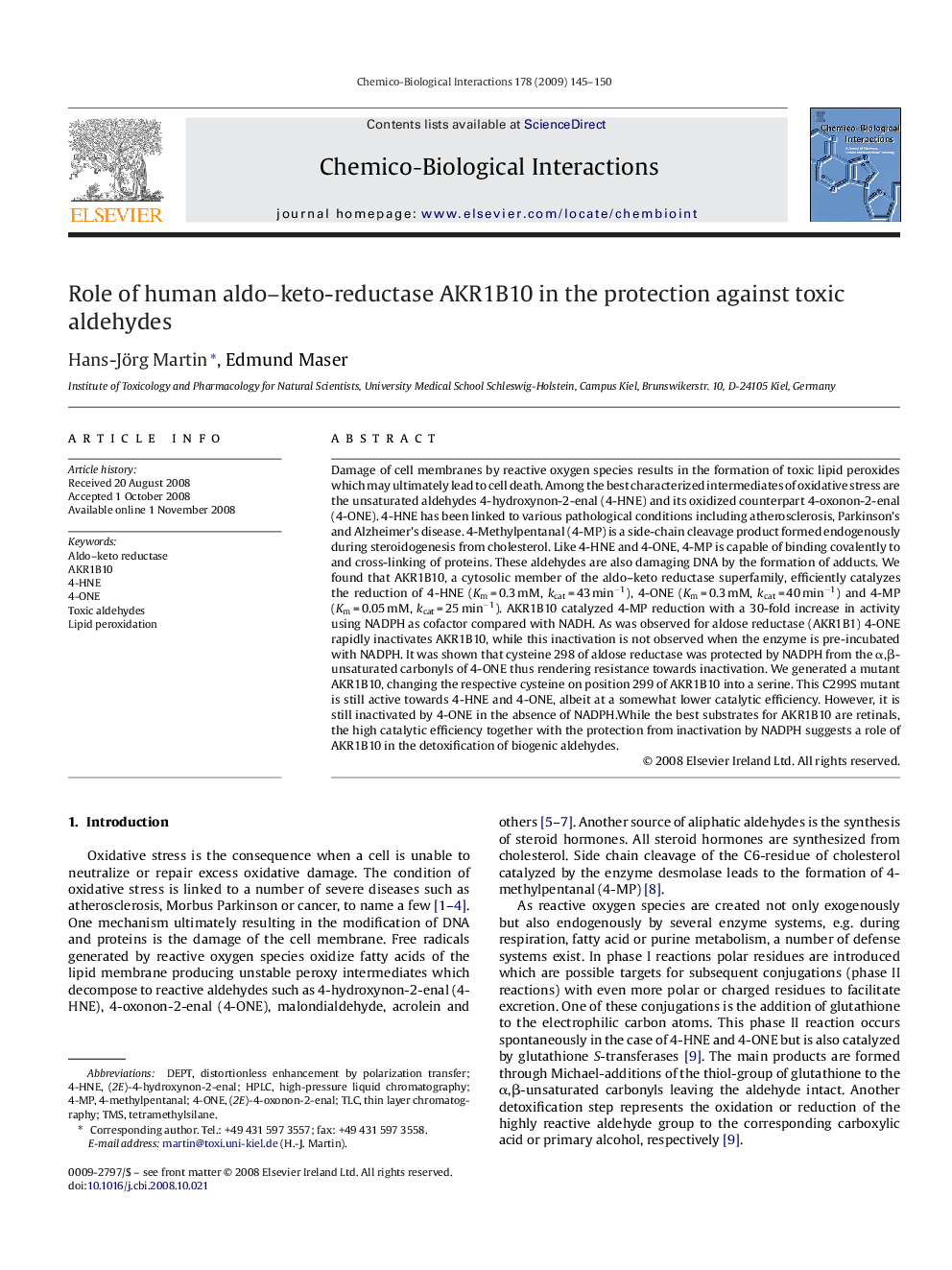| کد مقاله | کد نشریه | سال انتشار | مقاله انگلیسی | نسخه تمام متن |
|---|---|---|---|---|
| 2582334 | 1561651 | 2009 | 6 صفحه PDF | دانلود رایگان |
عنوان انگلیسی مقاله ISI
Role of human aldo-keto-reductase AKR1B10 in the protection against toxic aldehydes
دانلود مقاله + سفارش ترجمه
دانلود مقاله ISI انگلیسی
رایگان برای ایرانیان
کلمات کلیدی
4-HNETLCAKR1B10tetramethylsilaneDEPTTMS4-ONE4-MP - 4 مگاپیکسلaldo–keto reductase - آلدو کتو ردوکتازdistortionless enhancement by polarization transfer - افزایش تحرک توسط انتقال قطبشLipid peroxidation - پراکسیداسیون لیپیدthin layer chromatography - کروماتوگرافی لایه نازکhigh-pressure liquid chromatography - کروماتوگرافی مایع با فشار بالاHPLC - کروماتوگرافی مایعی کارا
موضوعات مرتبط
علوم زیستی و بیوفناوری
علوم محیط زیست
بهداشت، سم شناسی و جهش زایی
پیش نمایش صفحه اول مقاله

چکیده انگلیسی
Damage of cell membranes by reactive oxygen species results in the formation of toxic lipid peroxides which may ultimately lead to cell death. Among the best characterized intermediates of oxidative stress are the unsaturated aldehydes 4-hydroxynon-2-enal (4-HNE) and its oxidized counterpart 4-oxonon-2-enal (4-ONE). 4-HNE has been linked to various pathological conditions including atherosclerosis, Parkinson's and Alzheimer's disease. 4-Methylpentanal (4-MP) is a side-chain cleavage product formed endogenously during steroidogenesis from cholesterol. Like 4-HNE and 4-ONE, 4-MP is capable of binding covalently to and cross-linking of proteins. These aldehydes are also damaging DNA by the formation of adducts. We found that AKR1B10, a cytosolic member of the aldo-keto reductase superfamily, efficiently catalyzes the reduction of 4-HNE (Km = 0.3 mM, kcat = 43 minâ1), 4-ONE (Km = 0.3 mM, kcat = 40 minâ1) and 4-MP (Km = 0.05 mM, kcat = 25 minâ1). AKR1B10 catalyzed 4-MP reduction with a 30-fold increase in activity using NADPH as cofactor compared with NADH. As was observed for aldose reductase (AKR1B1) 4-ONE rapidly inactivates AKR1B10, while this inactivation is not observed when the enzyme is pre-incubated with NADPH. It was shown that cysteine 298 of aldose reductase was protected by NADPH from the α,β-unsaturated carbonyls of 4-ONE thus rendering resistance towards inactivation. We generated a mutant AKR1B10, changing the respective cysteine on position 299 of AKR1B10 into a serine. This C299S mutant is still active towards 4-HNE and 4-ONE, albeit at a somewhat lower catalytic efficiency. However, it is still inactivated by 4-ONE in the absence of NADPH.While the best substrates for AKR1B10 are retinals, the high catalytic efficiency together with the protection from inactivation by NADPH suggests a role of AKR1B10 in the detoxification of biogenic aldehydes.
ناشر
Database: Elsevier - ScienceDirect (ساینس دایرکت)
Journal: Chemico-Biological Interactions - Volume 178, Issues 1â3, 16 March 2009, Pages 145-150
Journal: Chemico-Biological Interactions - Volume 178, Issues 1â3, 16 March 2009, Pages 145-150
نویسندگان
Hans-Jörg Martin, Edmund Maser,